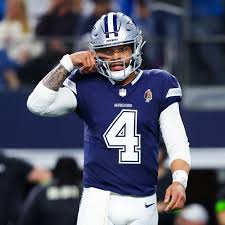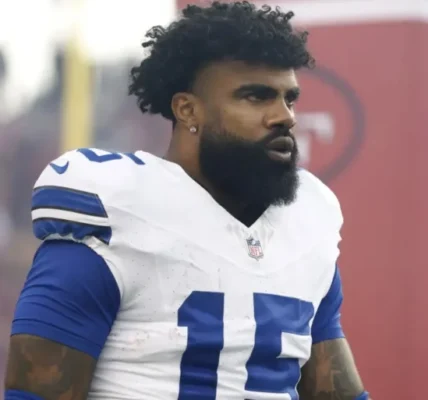The Dallas Cowboys are facing significant challenges, particularly on offense.
While the defense has received the majority of criticism due to its poor performance, injuries have also played a role in its struggles.
Conversely, the offense has fewer excuses, as most key players are healthy but still failing to meet expectations.
There are numerous issues plaguing the offense.
The running game stands out as a glaring problem, as the Cowboys rank last in the league for rushing yards this season.
Advanced statistics reveal that Rico Dowdle is 18th among running backs in EPA per attempt, while Ezekiel Elliott sits at 41st.
This suggests that while they may have one average running back, the overall talent in their backfield is lacking.
The offensive line is another area of concern.
As of Week 7, the Cowboys’ offensive line has a pass-block win rate of 57% (19th in the league) and a run-block win rate of 71% (18th).
These numbers indicate that they are performing slightly below average in both blocking categories.
Critics could point to questionable play-calling and ineffective route-running as additional problems.
While there are both positive and negative aspects to these areas, the offense is currently struggling with both passing and rushing efficiency, finding themselves in the worst quadrant for both metrics this season.
Surprisingly, the passing efficiency is lagging more than the rushing.
With Dak Prescott and CeeDee Lamb  on the roster, one might wonder how the passing game is underperforming.
on the roster, one might wonder how the passing game is underperforming.
The Cowboys are third in the league in passing yards, which indicates high overall volume, but factors like game script and the decision to abandon the run contribute to these statistics.
In terms of efficiency, however, the passing game is not performing well, and Prescott’s performance is a significant factor.
To analyze Prescott’s play, advanced statistics provide insight into his performance this season.
When examining expected points added, it’s clear that Prescott’s value has declined significantly. Similarly, looking at his completion percentage over expected shows a consistent downward trend.
When these metrics are combined, they tell a cohesive story about his performance.
Throughout his career, Prescott has typically hovered around the top 10 among quarterbacks.
Although his play dipped in 2018, this can largely be attributed to an insufficient receiving corps, which included seven games without Amari Cooper.
To further contextualize Prescott’s performance, a visual comparison of his seasons highlights how this year stands out for all the wrong reasons.
This analysis does not paint a favorable picture of the franchise quarterback.
It wouldn’t be surprising if comments arose stating, “They should’ve never paid him $60 million a year.”
If every game Prescott has played (120 total) received a reaction for such comments, it would likely gain traction. However, this is not an argument that Prescott is a bad player.
Data from the previous year clearly shows his capabilities.
Instead, the focus here is on how he is not playing well this season and is contributing to the offense’s failures.
The solution is straightforward: Prescott needs to elevate his play.
The idea of replacing him is not viable, both due to the financial implications and the belief that he is capable of performing better than he has shown.
The Cowboys must also address other issues within the offense; thus, while Dak shares part of the blame, he is not solely responsible for their struggles.
BIf he does not improve soon, the team’s offensive woes are unlikely to resolve.
In summary, while the Cowboys’ problems on offense are multifaceted, Dak Prescott’s current level of play is a significant contributor.
Improving his performance is crucial, and while other areas require attention, the quarterback’s ability to rebound will be vital for the team’s success moving forward.




